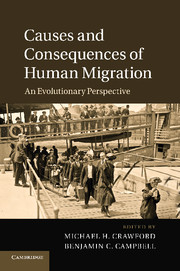26 - Why do we migrate? A retrospective
Published online by Cambridge University Press: 05 December 2012
Summary
Introduction
The scientific study of migration, and of migrants, has a long history in anthropology, genetics, and medicine (Boas, 1912; Chakraborty and Szathmary, 1985; Crawford, 1976, 1984; Morton et al., 1982). Yet in anthropological genetics it has been a decade since the publication of Goldstein and Chikhi’s (2002) review of the relevance of human migration and population structure studies and even longer since the appearance of Fix’s (1999) volume on migration, colonization, and microevolution. The time is ripe for a re-examination of human migration in the context of new methods of molecular analysis, a re-examination of historical, economic, and ecological motivations for migration, as well as continuing refinements and extensions of the archaeological and paleoecological records that inform our understanding of past population movements. This volume successfully provides such an updated perspective on the field, and serves as a valuable adjunct to the historical-economic examination of modern migration by Goldin et al. (2011) and the recent anthropological perspective on migration by Cabana and Clark (2011). These new treatments, along with the current volume, highlight the growing perception of migration not only as an evolutionary mechanism, but as a primary agent of structure and change in the deep past that echoes in the contemporary world.
The multidisciplinary conference upon which this volume is based was a gathering of over 100 scholars who engaged in spirited debate and discussion over the course of the meeting. It was an exciting and gratifying experience. The timeliness of the discussions is reflected in the chapters in this volume, and those initial discussions have been enhanced by the perspectives provided by several chapters that were not represented at the original meeting (noted in the Preface). It would be a disservice to the authors of the chapters to attempt a detailed summary and review of their contributions. They present a daunting array of data (both new and old), analysis, and inference on migration in diverse contexts far more eloquently than any brief summary could capture. Some concluding thoughts regarding alternative approaches to the study of migration, what has been done, and what might yet be done, seems worthy of some retrospection, however.
- Type
- Chapter
- Information
- Causes and Consequences of Human MigrationAn Evolutionary Perspective, pp. 527 - 536Publisher: Cambridge University PressPrint publication year: 2012
References
- 4
- Cited by



